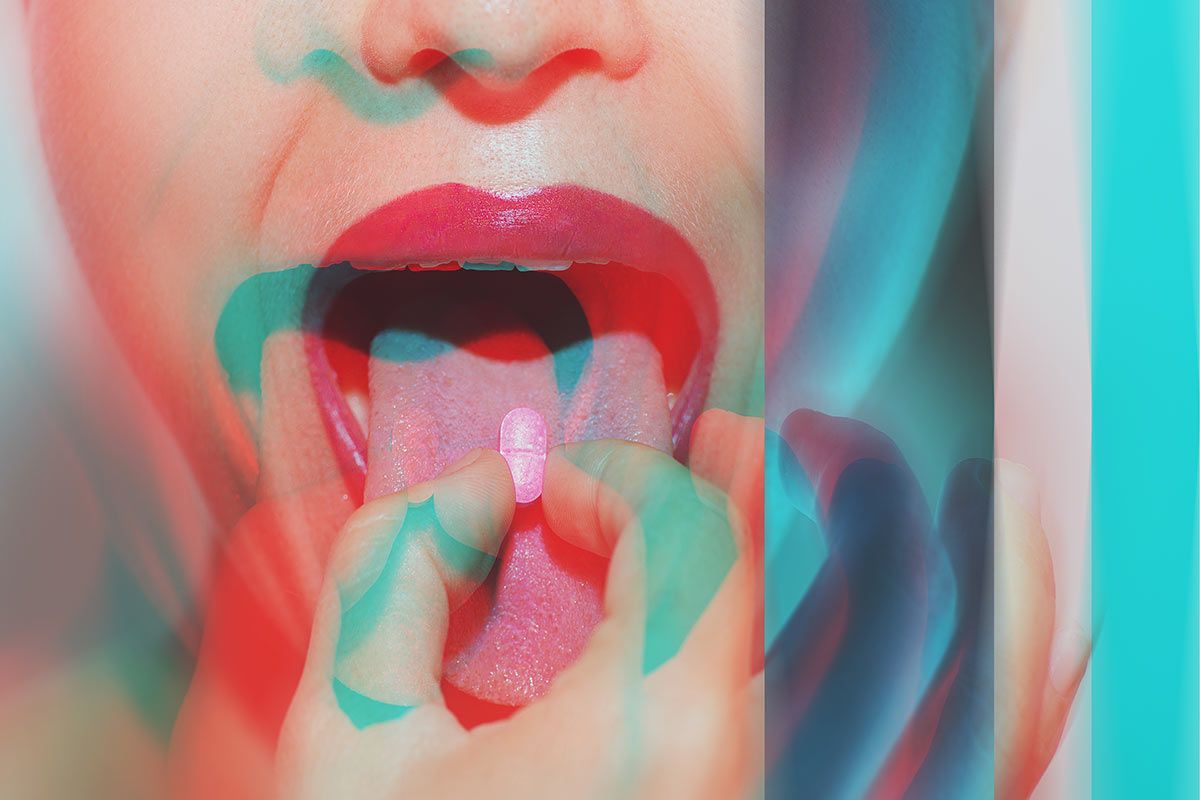MDMA is a synthetic psychedelic and stimulant. Many people associate it with party drugs and raves, but its utility as a treatment for PTSD has brought it to the medical stage. Where does MDMA come from? Let’s tackle this and other common questions about the origins of MDMA.
MDMA stands for 3,4-methylenedioxy-methylamphetamine [1]. Unlike other “natural” psychedelics like psilocybin, it is not found in nature and can only be made in a lab.
MDMA is a methamphetamine derivative, but it doesn’t have as much stimulant and addictive qualities as methamphetamines [2]. It’s also structurally similar to mescaline, explaining its hallucinogenic as well as stimulant effects. While MDMA does produce acute psychedelic experiences, it’s less associated with psychosis than other psychedelics like LSD.
Where does MDMA come from?
MDMA was discovered in 1912 by the German pharma company Merck. You may have heard that it was developed as an appetite suppressant for German soldiers, but this is not true. The real story isn’t one of the medical advancements in warfare but of pharmaceutical competition.
Merk was developing a new way to synthesize medication to avoid patents from their competitor, Bayer. At the time, Bayer was making hydrastanin, the best clotting medication on the market. The Merck development team aimed to make a rival medication. MDMA, called methylsafrylin at the time, was not developed as a drug but as an intermediate synthesizer for clotting medication [3].
Because of this, MDMA wasn’t tested pharmacologically until much later even though it was patented in 1914. Merck didn’t study its effects in animals until 1927 [3]. That year, a chemist named Max Oberlin noticed chemical similarities between methylsafrylin and adrenaline. When he used it on test subjects, Oberlin saw effects on blood glucose and vascular tissue. However, Oberlin’s research was stalled when the German Depression caused steep rises in the cost of chemicals, and his experimental research halted [4].
When did people start using MDMA?
It’s not clear whether Merck ever tested MDMA on human subjects. Another Merck chemist named Wolfgang Fruhstorfer may have done stimulant testing on humans in 1959. Some believe that Fruhstorfer researched MDMA in cooperation with an institute for aviation medicine. Yet, documentation for this research is slim, so we don’t know if this is true [4].
In 1960, a Polish journal published the first paper on MDMA synthesis, and it was introduced in the States as a street drug in the late 60’s. Alexander “Sasha” Shulgin, a chemist in the San Francisco Bay area, originally synthesized MDMA to mimic a similar substance called MDA. MDA was already scheduled under the Controlled Substances Act, and MDMA was initially created as a legal alternative [5].
By 1970, Chicago police seized the first tablets containing MDMA, and the race to contain this psychoactive substance was on [4]. Between 1970 and 1974, most MDMA activity came from the Midwest before moving toward the West Coast in the late 70s [5]. Still, MDMA’s recreational use was still not widespread in the States until 1983 [8].
Why was MDMA made illegal in the US?
In 1984, the DEA found that MDMA was being distributed on a larger scale by a theology student in Texas [8]. Following this finding, the DEA cracked down on MDMA. They put an emergency ban on it in 1985, and it was named a Schedule-1 substance under the Controlled Substances Act [5]. Later that year, the World Health Organization’s Expert Committee on Drug Dependence followed with a similar decision [8].
Legislators at the time feared the addictive and mind-altering effects of MDMA, likening it to LSD. John Lawn, DEA Administrator, stated at the time that MDMA abuse had become a “nationwide problem that poses a serious health threat.” [6].
Some physicians opposed the ruling to make MDMA a scheduled substance. They cited its potential therapeutic qualities but didn’t have the evidence to counter the DEA’s fear of psychedelics [8].
On the international level, some advocates were able to gain more traction. Even as the WHO ruled against MDMA, they still supported further research and exploration of its therapeutic potential [8].
Despite its illegal status, MDMA, in its many forms, remains one of the more popular recreational substances in the States. Since its scheduling, there has been more contamination within underground drug procurement processes [7]. Ecstasy and Molly are often MDMA that is “cut” with something else, and at other times, these street-traded substances contain little or no MDMA.
Its illegal status has hampered studies into MDMA’s psychopharmacological uses, but in the last decades, research has shown that MDMA can be a useful tool in the form of MDMA-assisted therapy [7].
Where Does MDMA Therapy Come From?
Before its criminalization, MDMA gained interest among some psychiatrists. They felt that it could enhance communication and insight during couples’ therapy sessions, and it was used as a therapy tool before being outlawed. However, no controlled clinical trials had occurred at the time it was banned. This early work in MDMA therapy and integration helped lay the groundwork for psychedelic therapy today [8].
There’s not much concrete literature on MDMA therapy from the period before it was scheduled. Early explorers in MDMA therapy were likely not inclined to seek media attention due to the prior decade’s narratives around LSD. Researchers who did use MDMA often only alluded to it. Many put off publishing findings for some time or only published for a select group of people [8].
After it was criminalized in 1985, the first American studies for MDMA in animals helped establish it for FDA-approved research. In 1992, the first FDA-approved study on MDMA in humans began [8].
MDMA has potential applications in group therapy, although this has not been tested yet. One small couple’s study using MDMA in PTSD has been done, but more large research into group MDMA therapy is hopefully to come [8].
MDMA has proven most effective for people with reactive disorders such as Post-Traumatic Stress Disorder [9]. Most recently, MDMA has made headlines for its ability to help people with treatment-resistant PTSD [10]. Because of great outcomes in research, the Multidisciplinary Association of Psychedelic Studies (MAPS), now Lykos Therapeutics, applied for FDA approval for MDMA in 2024 after completing a second phase 3 trial, but the new drug application was rejected, and the FDA requested an additional phase 3 trial.
What are the effects of MDMA in therapy?
MDMA’s effects last for several hours in humans. The subjective effects during an active MDMA session include [5]:
- feeling more open
- enhanced trust with the therapist
- increased alertness
- reduced social inhibition
- positive mood/euphoria
- heightened sensory and somatic (body) experiences
MDMA is “weakly hallucinogenic”, in that it doesn’t cause auditory hallucinations and creates visual hallucinations in only 20% of users. Even these visual hallucinations are not concrete, typically described as peripheral light flashes [5].
After an MDMA session, patients are invited to integrate their experience with the help of a trained psychedelic therapist. The evidence for efficacy in MDMA therapy is strong, with rapid onset of improved symptoms that endure after treatment for many patients [10]1.
How Does MDMA Work in Therapy?
MDMA is chemically related to amphetamine, sharing the same core structure as other psychostimulants like methamphetamine and methylphenidate. Hallucinogens like mescaline are also structurally similar to MDMA. These combined similarities between hallucinogens and stimulants are what give MDMA its unique characteristics [11].
Yet MDMA has some effects that are unlike hallucinogens and stimulants. It’s one of the very few substances that promote “prosocial” behaviors, meaning it generally makes people more inclined to interact with others in a social environment. MDMA also changes people’s inward-facing perceptions or their senses of their own internal states [5].
MDMA’s pro-social and inward-facing effects make it a powerful tool in psychotherapy. By activating feel-good hormones like dopamine and serotonin, MDMA helps people with PTSD open up about their traumatic memories while decreasing their anxiety [10]. It could also work by helping people ignore negative emotions and perceptions, making them more inclined toward positive mood [12].
In patients with PTSD, MDMA therapy has proven to be dramatic and life-changing. In one 2021 study, nearly 70% of participants who received MDMA therapy did not qualify for a PTSD diagnosis a year later. This is a stark contrast to traditional psychotherapy, which has a limited effectiveness for people with PTSD [10].
Yet MDMA’s potential uses may not be limited to PTSD alone. Some other potential areas for MDMA treatment include eating disorders [13], anxiety disorders [14], addiction, and more [15]. Stay tuned for more research around this exciting therapeutic substance.
To learn more about MDMA-assisted therapy, check out our MDMA therapy guide.
References:
- Drug Enforcement Agency. (n.d.). Drug fact sheet: Ectasty/MDMA – Dea. dea.gov. Retrieved February 21, 2022, from https://www.dea.gov/sites/default/files/2020-06/Ecstasy-MDMA-2020.pdf
- Gahlinger, P. M. (2004, June 1). Club drugs: MDMA, gamma-hydroxybutyrate (GHB), Rohypnol, and ketamine. American Family Physician. Retrieved February 21, 2022, from https://www.aafp.org/afp/2004/0601/p2619.html#:~:text=MDMA%20is%20structurally%20similar%20to,LSD%20and%20other%20potent%20hallucinogens.
- Freudenmann, R. W., Öxler, F., & Bernschneider-Reif, S. (2006). The origin of MDMA (Ecstasy) Revisited: The True Story reconstructed from the original documents. Addiction, 101(9), 1241–1245. https://doi.org/10.1111/j.1360-0443.2006.01511.x
- Adam, David (2006, October). Origins of Ecstasy an Urban Myth. NatureReviews Drug Discovery 5, 806. DOI https://doi.org/10.1038/nrd2172 . Retrieved February 21, 2022, from https://www.nature.com/articles/nrd2172.pdf
- Passie, T., & Benzenhöfer, U. (2016). The history of MDMA as an underground drug in the United States, 1960–1979. Journal of Psychoactive Drugs, 48(2), 67–75. https://doi.org/10.1080/02791072.2015.1128580
- Ap. (1985, June 1). U.S. will ban ‘ecstasy,’ a hallucinogenic drug. The New York Times. Retrieved February 22, 2022, from https://www.nytimes.com/1985/06/01/us/us-will-ban-ecstasy-a-hallucinogenic-drug.html
- Pentney, A. R. (2001). An exploration of the history and controversies surrounding MDMA and MDA. Journal of Psychoactive Drugs, 33(3), 213–221. https://doi.org/10.1080/02791072.2001.10400568
- Passie, T. (2018). The early use of MDMA (‘ecstasy’) in Psychotherapy (1977–1985). Drug Science, Policy and Law, 4, 205032451876744. https://doi.org/10.1177/2050324518767442
- U.S. Department of Health and Human Services. (2021, April 13). What is the history of MDMA? National Institutes of Health.
- Yazar-Klosinski, B., & Mitchell, J. (2021). A randomized, double-blind, placebo-controlled phase 3 study assessing efficacy and safety of MDMA-assisted therapy for the treatment of severe PTSD. Biological Psychiatry, 89(9). https://doi.org/10.1016/j.biopsych.2021.02.270
- Dunlap, L. E., Andrews, A. M., & Olson, D. E. (2018). Dark classics in chemical neuroscience: 3,4-methylenedioxymethamphetamine. ACS Chemical Neuroscience, 9(10), 2408–2427. https://doi.org/10.1021/acschemneuro.8b00155
- Kirkpatrick, M. G., Lee, R., Wardle, M. C., Jacob, S., & de Wit, H. (2014). Effects of MDMA and intranasal oxytocin on social and emotional processing. Neuropsychopharmacology, 39(7), 1654–1663. https://doi.org/10.1038/npp.2014.12
- Brewerton, T. D., Lafrance, A., & Mithoefer, M. C. (2021). The potential use of N-methyl-3,4-methylenedioxyamphetamine (MDMA) assisted psychotherapy in the treatment of eating disorders comorbid with PTSD. Medical Hypotheses, 146, 110367. https://doi.org/10.1016/j.mehy.2020.110367
- Luoma, J., & Lear, M. K. (2021). MDMA-assisted therapy as a means to alter affective, cognitive, behavioral, and neurological systems underlying social dysfunction in social anxiety disorder. Frontiers in Psychiatry, 12. https://doi.org/10.3389/fpsyt.2021.733893
- Pantoni, M. M., Kim, J. L., Van Alstyne, K. R., & Anagnostaras, S. G. (2022). MDMA and memory, addiction, and depression: Dose-effect analysis. Psychopharmacology. https://doi.org/10.1007/s00213-022-06086-9






